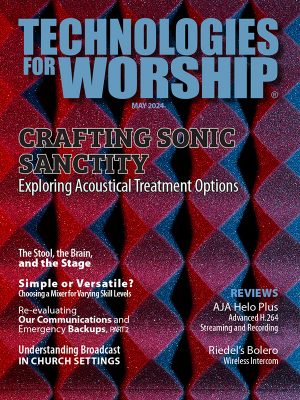 We know, we know: worship rigging, often times, isn’t all that exciting – but honestly, do you want it to be? Exciting rigging is rigging that’s failed, or is failing, which means falling equipment and, potentially, serious injury or even death. Not the type of excitement you want during a worship service. If your audience is busy dodging light fixtures and speaker components, they’re not focused on the message.
We know, we know: worship rigging, often times, isn’t all that exciting – but honestly, do you want it to be? Exciting rigging is rigging that’s failed, or is failing, which means falling equipment and, potentially, serious injury or even death. Not the type of excitement you want during a worship service. If your audience is busy dodging light fixtures and speaker components, they’re not focused on the message.
Stage rigging and trussing are the backbone of a professional AVL install, whether it’s fixed or portable. We’ve all heard horror stories about stages collapsing and people being killed, and we all think accidents like that could never happen at our church – but are we really sure?
Think about all the components involved with your AVL: the gear itself, the cabling, the rigging and truss, and the components used to secure your gear to the wall, the ceiling, the trussing…is it safe?
By its very nature, stage rigging involves several components; some of them are fixed, some of them move. Make a quick mental list in your head of all the equipment you have hanging overhead or from the walls: projectors, fixed screens or ones that retract into the ceiling with a push of a button, PTZ and other types of cameras positioned on the walls, different types of light fixtures…the size of your mental list might surprise you.
Think of the weight of this gear – projectors aren’t light, nor are screens. Light fixtures, especially if there are multiple fixtures hung from a lighting grid on stage, weigh a lot… and that’s not counting the weight of the cables needed to provide electricity and, in some cases, control of the equipment to various consoles, stage boxes, etc. Just like your equipment will eventually wear out and need replaced, so too will the fasteners, hooks, and chains safely supporting that equipment.
The question becomes: how do you keep your church community safe, and protect the money you’ve invested in your AVL equipment? The short answer: INSPECTION.
Having a certified rigger or installer inspect your stage rigging on an annual basis is one of the smartest investments you will ever make. Outside the obvious reason that things wear out, regularly inspecting your stage rigging helps prevent accidents before they can happen.
TRUSSING & RIGGING
Certified riggers know what to look for in relation to potential failure points; they also know how to spot potentially dangerous and incorrect rigging. People make mistakes; a professional rigger will be able to tell you if any of your equipment is installed incorrectly and recommend the best way to correct this potentially serious issue.
Perhaps you have too much weight on a piece of trussing, or the wrong fastener or clamp is being used to support a speaker or a light fixture; again, a certified rigger will be able to spot these errors. If a rope or cable is stretching or starting to fray, you want to know about it before it breaks and allows whatever it’s supporting to come crashing down.
A good rigging inspector will discover problems, notice wear, and be able to advise you on potential problems before they occur. They will be able to easily recognize whether the rigging you are using is strong enough to support the weight load of the equipment attached to it.
They will also know how to look for signs that any synthetic stage rope being used is wearing out, abrading, or starting to rot, and advise you on when the rope needs to be replaced.
You can also go online and look for local inspectors via USITT (http://www.usitt.org) and ESTA (http://www.esta.org).
Once you’ve found someone, ask for a written proposal upfront outlining the cost of the inspection, and what they will be looking for – you want them to look at everything, from the trussing through to the fasteners and the equipment itself.
Remember: what goes up also comes down. An annual rigging inspector will help ensure this DOESN’T happen until you want it to.





